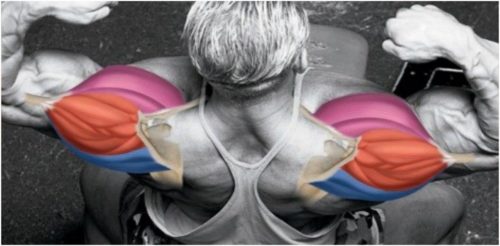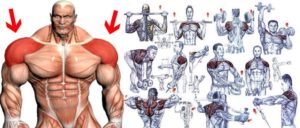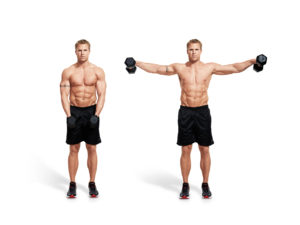Every bodybuilder wants to have the perfect physique, but in order to get there, they will need to put a lot of blood, sweat and tears into it. In order to help with this quest, this article contains an eight week plan that will help anyone that uses it by widening their shoulders and increasing their size overall.
This workout plan has two phases and each of them bolsters a certain part of muscle growth. The first part of the plan encompasses the first four weeks of the plan, and you’ll be doing a lot of lifting of really heavy weights with a low number of reps. Of course, this is really intense and will place stress on your muscles like never before. The techniques used here are incredibly high intensity. These techniques are forced or negative reps, extended and drop sets.
When you utilize techniques like this, your muscles go into overload and take a lot more damage than the usual. When any of your muscle cells sustain damage because of the intensity of resistance training, they are immediately replaced with new cells, which are bigger, stronger and more durable than the previous. Your body does this to protect itself by adapting to difficult and stressful situations. If you’ve been lifting for a while, you’re probably starting to notice that you can’t really build muscle as efficiently as you used to, since your muscle fibers are already incredibly strong and can’t be damaged and replenished very easily. This just means that you will need to train with incredibly heavy weights and techniques that bring new meaning to the word “intensity”. After that, your muscles will overload, damage themselves and you will be inadvertently guaranteed muscle growth.
The key to this plan is following a five day split that will assist you in making your shoulders really big, but training all of your other muscles as well. When you train your deltoids just once per week, you will be able to efficiently recover from your high-intensity workouts, which will give your body just enough time to create new muscle cells to replace the old ones, which will help you grow. As I said before, this all takes place in two phases, so let’s get right to it.
1. Phase One
In this phase, you will need to train only your deltoids one day of the week. All other parts of your workout routine should continue as planned, but make sure that high intensity exercises are only part of your deltoid workout – you don’t want your body concentrating on the other muscle groups since this part is just about the delts. Start your shoulder workout with two seats of seated barbell shoulder presses with negative and forced repetitions.
You will need to choose a weight that will let you lift it six times before reaching muscle failure. However, when you do reach it, take a few extra steps that will help you a lot, such as:
Enjoy a very slow, five second cadence while you lower the weight from over your head to your upper chest.
If you have a gym buddy, ask for their help, but you can do this alone as well – lift the bar back up. Simple, right? Do this twice more.
After that, you will want to do two more sets of shoulder presses with extended sets.
This type of sets will let you keep performing a movement for more reps – all you have to do is adjust your body to a more optimal bio-mechanical stance.
Perform a set of seated presses for six reps. When you feel muscle failure approaching, stop before you get to it and do a superset with some standing barbell shoulder presses until you get there.
Make sure that you use the same weight for both exercises.
Get up and do some standing shoulder presses which will be easier for you since you will be able to utilize your legs to explode the weight upwards. You’ll need this, since your deltoids will start tiring.
You will need to perform two sets of this.
Next, you’ll have some seated as well as standing dumbbell lateral raises put together into an extended set.
Get a weight that will let you do eight repetitions of seated lateral raises.
Start doing them but halt once you feel muscle failure approaching. Stand up and keep doing the set until your muscles fail. Getting up will help you since you will be able to utilize that little bounce in your legs and your body which will help you in doing some more reps.
When you do reach muscle failure, do two negative or forced reps as described in the pressing exercises.
Do three sets of this.
Finally, you will need to concentrate on your front and rear heads with some seated alternating dumbbell front raises and some incline-bench bent dumbbell lateral raises. Do three sets of each of these exercises.
The first sets of both exercises will need to be performed like a straight set with eight reps, ending in muscle failure.
The second sets will have you going to muscle failure and then taking some weight off, about 20 to 30 percent of it. Do as many reps as you can like this.
The third sets should be drop sets performed after reaching failure. Take some weight off the original number – I suggest you remove 20 to 30 percent of it, and do as many repetitions as you humanly can, then removing another 20 to 30 percent and going as far as you can go with reps.
Here is a complete workout plan for this phase.
MONDAY – Chest and Abs
TUESDAY – Legs and Calves
WEDNESDAY – Rest
THURSDAY – Deltoids
FRIDAY – Back and Traps
SATURDAY – Biceps, Triceps and Abs
SUNDAY – Rest
Also, here is a list of exercises that comprise the deltoids workout which you should be doing every Thursday. Try to boost the weight every week, on all exercises.
Seated barbell presses for 2 sets, 6 reps each. 2-3 minutes of rest. After the last rep, do three negative or forced reps.
Seated barbell presses for 2 sets, 6 reps each to muscle failure, superset with standing barbell presses for 2 sets until muscle failure. 2-3 minutes of rest. Use the same weight for both of these exercises.
Seated dumbbell lateral raises for 3 sets, 8 reps each until muscle failure, superset with standing dumbbell lateral raises for 3 sets until muscle failure. 2 minutes of rest. Use the same weight for the entire superset, but when you get to muscle failure on the standing dumbbell lateral raises, make sure to do two negative or forced reps.
Seated alternating dumbbell front raises for 3 sets, 8 reps each. 2 minutes of rest. When you get to the second set, do a single drop set. When you get to the last set, do two drop sets.
Incline-bench bent dumbbell lateral raises for 3 sets, 8 reps each. 2 minutes of rest. When you get to the second set, do a single drop set. When you get to the last set, do two drop sets for maximum efficiency.
2. Phase Two
This phase will have you follow a five day split, but you will train your deltoids twice per week because you will need to stress them more. One of the training sessions will be very light and short, performed right after doing a chest workout, but the other one will be a really intense and stressful workout after a rest day, later in the week.
While the first phase concentrated on growing your muscles, after doing it for four weeks, it will start losing its effects. For instance, your muscle fibers will resist a lot of damage, so you will have to change your focal point to that of boosting muscle growth with a different method, which will make some genes increase activity that will jump-start protein synthesis in your muscles. Muscles are made out of protein, so the more protein your body synthesizes, the more muscles you have and the bigger they are. When you train your deltoids twice a week like this method suggests, you will make your gene activity keep your protein synthesis really high, constantly.
Your first deltoid workout of the week should be on Monday, right after your chest workout, and it will be mostly made up of cable exercises. Cables have a very nifty trait – their line of pull will let you maintain constant stress on your delts, all the way through your range of motion, which will let you target more muscle fibers in those specific muscles. The workout should begin with some two arm standing cable lateral raises so that you can hit your middle deltoids properly, but it finishes with some incline bench bent cable lateral raises so that you can get your rear deltoids as well.
This workout does not encompass any special front deltoid exercises because it’s right after chest training, which already activates your front deltoids. All of your exercises will have you following some simple rules such as these.
Do four sets with a minute of rest in between.
For your first set, pick a weight that will let you lift it 20 times before you reach muscle failure.
For your second set, put some more weight on, until you can lift it 15 times.
Set number three will have you putting on even more weight and lifting it exactly 12 times.
The final set requires that you put on more weight which will let you lift it 10 times before muscle failure.
If you get tired really fast and your muscles don’t recover really quickly, you can probably leave the primary weight untouched if you want to hit those lower rep sets properly. In fact, you might even get so tired that you won’t be able to do more than what the target says with even the primary weight, let alone adding more.
The second deltoid workout should be on Friday, after resting for an entire day on Thursday. By doing this, you are making sure that you will have enough energy to survive the intense training for your second deltoid workout. This workout will have you doing some pre-exhaust superset training which will have a set of an isolation exercise like some dumbbell lateral raises, and a set of a multi-joint exercise, like seated dumbbell shoulder presses. This method tires out your targeted muscle, which is the middle deltoid head in this case, so this muscle becomes the weakest link when you start doing the multi-joint exercise. By doing this, you make sure that your failure when you do the multi-joint exercise depends on the targeted muscle and not the muscles that assist it. You also have some other perks, traits and options.
Do dumbbell lateral raises in a superset with seated dumbbell shoulder presses.
Do standing dumbbell lateral raises in a superset with Smith machine behind the neck presses.
Do some seated alternating dumbbell front raises, in a superset with incline-bench bent dumbbell lateral raises. This will complete your deltoid routine for all three heads of the muscle.
Here is a complete workout plan for this phase.
MONDAY – Chest and Deltoids (light training)
TUESDAY – Back, Traps and Abs
WEDNESDAY – Legs and Calves
THURSDAY – Rest
FRIDAY – Deltoids (heavy training)
SATURDAY – Biceps and Triceps
SUNDAY – Rest
Also, here is a list of exercises that comprise the deltoids workout which you should be doing every Monday and Friday.
Workout 1 – Monday
Standing cable lateral raises with both arms for 4 sets, with 20, 15, 12 and 10 reps each. 1 minute of rest.
Incline-bench bent cable lateral raises for 4 sets, with 20, 15, 12 and 10 reps each. 1 minute of rest.
Workout 2 – Friday
Seated dumbbell lateral raises for 2 sets, 12 reps each. Superset with seated dumbbell presses for 2 sets with 10 reps each. Rest for 2 minutes.
Standing dumbbell lateral raises for 2 sets, 12 reps each. Superset with Smith machine behind the neck presses for 2 sets, 10 reps each. Rest for 2 minutes.
Seated alternating dumbbell front raises for 3 sets with 10, 12 and 15 reps each. Rest for a minute.
Incline-bench bent dumbbell lateral raises for 3 sets with 10, 12 and 15 reps each. Rest for a minute.






Post your comment